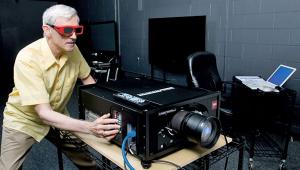3D: Glasses-Free At Last?


Graphic courtesy 3D-Forums.com
Here's how autostereoscopic 3D works: A filter in front of the screen directs the light from alternating columns of pixels in slightly different directions, forming the left- and right-eye images. This filter can be one of two types—a parallax barrier (depicted above) or a series of lenticular "lenslets" (depicted below).

Graphic courtesy 3D-Forums.com
Either way, this cuts the horizontal resolution seen by each eye in half, and you have to be in one of several very specific positions with respect to the screen to see the 3D effect.

Graphic courtesy 3D-Forums.com
If you're too far away, you'll see a blended (i.e., 2D) image; if you're at the wrong angle with the center line, the left and right images could be flipped. In some positions, I've seen wavy distortions throughout the picture, which are sometimes called ripple artifacts. To avoid these problems, all the demos at CES this year had marks on the floor indicating where viewers should stand to see the 3D effect on a given screen.
Toshiba was making the biggest deal of autostereoscopic 3D at CES with 56- and 65-inch lenticular LCD prototypes that are supposed to become commercial products by late this year or early next year, though no pricing has yet been announced. Both LCD panels have a native resolution of 4K (4096x2160), so each eye sees full 1080p, but the company would not reveal what happens with the extra 1080 vertical pixels—or, for that matter, the extra 256 horizontal pixels—in 3D mode. Neither would it discuss whether or not the display upconverts 1080p 2D content to 4K.
Sony also had an autostereoscopic flat panel on display at CES, a 24.5-inch OLED concept product with no scheduled release date or price. The native panel resolution was 1920x1080, and according to Sony, the resolution seen by each eye in 3D mode was only 640x360. I asked why the 3D resolution was so low, but a company rep would not discuss it, nor would he reveal whether the technology was lenticular or parallax barrier.
In both cases, I thought the 3D effect was not nearly as pronounced as glasses-based displays, even when standing in the correct spot as indicated by marks on the floor. And moving even a few inches left, right, or farther away caused ripple artifacts or destroyed the illusion altogether. Then there's the display's performance with 2D images—we didn't see any such images at CES, but I can't imagine that the autostereoscopic filter doesn't degrade the 2D picture quality in some way.
Overall, I must agree with Clauser, Wolpin, and others who denounce autostereoscopic 3D in its current form. Not only does it not look that good, it muddies the waters of the 3D marketplace, which is struggling as it is. No one likes having to wear glasses to see 3D, but the answer is not to introduce an inferior technology. If you enjoy the 3D TV experience, stick with glasses until true holographic video is perfected—and don't hold your breath for that!
- Log in or register to post comments





















































